Climate Change and Viticulture in Italy: Historical Trends and Future Scenarios
Abstract
:1. Introduction
2. Materials and Methods
2.1. Study Area, Climate Historical Data, Future Scenarios, and Bioclimatic Indices
2.2. Historical Trends of Bioclimatic Indices in Italy
2.3. Geostatistical Interpolation Techniques
3. Results
3.1. Historical Data
3.2. Future Scenarios
4. Discussion
5. Conclusions
Supplementary Materials
Author Contributions
Funding
Institutional Review Board Statement
Informed Consent Statement
Data Availability Statement
Conflicts of Interest
References
- Torquati, B.; Giacchè, G.; Venanzi, S. Economic analysis of the traditional cultural vineyard landscapes in Italy. J. Rural. Stud. 2015, 39, 122–132. [Google Scholar] [CrossRef]
- Massano, L.; Fosser, G.; Gaetani, M.; Bois, B. Assessment of climate impact on grape productivity: A new application for bioclimatic indices in Italy. Sci. Total Environ. 2023, 905, 167134. [Google Scholar] [CrossRef]
- Biasi, R.; Brunori, E.; Ferrara, C.; Salvati, L. Assessing Impacts of Climate Change on Phenology and Quality Traits of Vitis vinifera L.: The Contribution of Local Knowledge. Plants 2019, 8, 121. [Google Scholar] [CrossRef]
- Costa, R.; Fraga, H.; Fonseca, A.; de Cortazar-Atauri, I.G.; Val, M.C.; Carlos, C.; Reis, S.; Santos, J.A. Grapevine Phenology of cv. Touriga Franca and Touriga Nacional in the Douro Wine Region: Modelling and Climate Change Projections. Agronomy 2019, 9, 210. [Google Scholar] [CrossRef]
- van Leeuwen, C.; Darriet, P. The Impact of Climate Change on Viticulture and Wine Quality. J. Wine Econ. 2016, 11, 150–167. [Google Scholar] [CrossRef]
- van Leeuwen, C.; Sgubin, G.; Bois, B.; Ollat, N.; Swingedouw, D.; Zito, S.; Gambetta, G.A. Climate change impacts and adaptations of wine production. Nat. Rev. Earth Environ. 2024, 5, 258–275. [Google Scholar] [CrossRef]
- Moriondo, M.; Jones, G.V.; Bois, B.; Dibari, C.; Ferrise, R.; Trombi, G.; Bindi, M. Projected shifts of wine regions in response to climate change. Clim. Chang. 2013, 119, 825–839. [Google Scholar] [CrossRef]
- Piña–Rey, A.; González–Fernández, E.; Fernández–González, M.; Lorenzo, M.A.; Rodríguez-Rajo, F.J. Climate Change Impacts Assessment on Wine–Growing Bioclimatic Transition Areas. Agriculture 2020, 10, 605. [Google Scholar] [CrossRef]
- Charalampopoulos, I.; Polychroni, I.; Droulia, F.; Nastos, P.T. The Spatiotemporal Evolution of the Growing Degree Days Agroclimatic Index for Viticulture over the Northern Mediterranean Basin. Atmosphere 2024, 15, 485. [Google Scholar] [CrossRef]
- Irimia, L.M.; Patriche, C.V.; Petitjean, T.; Tissot, C.; Santesteban, L.G.; Neethling, E.; Foss, C.; Le Roux, R.; Quénol, H. Structural and Spatial Shifts in the Viticulture Potential of Main European Wine Regions as an Effect of Climate Change. Horticulturae 2024, 10, 413. [Google Scholar] [CrossRef]
- Fratianni, S.; Acquaotta, F. The Climate of Italy. In Landscapes and Landforms of Italy; Soldati, M., Marchetti, M., Eds.; World Geomorphological Landscapes; Springer: Cham, Switzerland, 2017. [Google Scholar] [CrossRef]
- Alikadic, A.; Pertot, I.; Eccel, E.; Dolci, C.; Zarbo, C.; Caffarra, A.; De Filippi, R.; Furlanello, C. The impact of climate change on grapevine phenology and the influence of elevation: A regional study. Agric. For. Meteorol. 2019, 271, 73–82. [Google Scholar] [CrossRef]
- Gaiotti, F.; Pastore, C.; Filippetti, I.; Lovat, L.; Belfiore, N.; Tomasi, D. Low night temperature at veraison enhances the accumulation of anthocyanins in Corvina grapes (Vitis vinifera L.). Sci. Rep. 2018, 8, 8719. [Google Scholar] [CrossRef]
- Amato, V.; Valletta, M. Wine Landscapes of Italy. In Landscapes and Landforms of Italy; Soldati, M., Marchetti, M., Eds.; World Geomorphological Landscapes; Springer: Cham, Switzerland, 2017. [Google Scholar] [CrossRef]
- Lamonaca, E.; Seccia, A.; Santeramo, F.G. Climate Cha(lle)nges in global wine production and trade patterns. Wine Econ. Policy 2023, 12, 85–102. [Google Scholar] [CrossRef]
- OIV. OIV Guidelines for Studying Climate Variability on Vitiviniculture in the Context of Climate Change and Its Evelution. 2015, pp. 1–7. Available online: https://www.oiv.int/public/medias/426/viti-2015-1-en.pdf (accessed on 13 June 2024).
- Tonietto, J.; Carbonneau, A. A multicriteria climatic classification system for grape–growing regions worldwide. Agric. For. Meteorol. 2004, 124, 81–97. [Google Scholar] [CrossRef]
- Huglin, P. Nouveau mode d’évaluation des possibilités héliothermiques d’un milieu viticole. Comptes Rendus L’académie D’agriculture Fr. 1978, 64, 1117–1126. [Google Scholar]
- Tonietto, J. Les Macroclimats Viticoles Mondiaux et L’influence du Mésoclimat sur la Typicité de la Syrah et du Muscat de Hambourg dans le sud de la France: Méthodologie de Caráctérisation. Ph.D. Thesis, Ecole Nationale Supérieure Agronomique, Montpellier, France, 1999; p. 233. [Google Scholar]
- Riou, C.; Becker, N.; Sotes Ruiz, V.; Gomez-Miguel, V.; Carbonneau, A.; Panagiotou, M.; Calo, A.; Costacurta, A.; Castro de, R.; Pinto, A.; et al. Le Déterminisme Climatique de la Maturation du Raisin: Application au Zonage de la Teneur em Sucre dans la Communauté Européenne; Office des Publications Officielles des Communautés Européennes: Luxembourg, 1994; p. 322. Available online: https://op.europa.eu/fr/publication-detail/-/publication/3edc0da9-f95a-4d53-871a-594267de7956/language-fr (accessed on 13 June 2024).
- Modina, D.; Cola, G.; Bianchi, D.; Bolognini, M.; Mancini, S.; Foianini, I.; Cappelletti, A.; Failla, O.; Brancadoro, L. Alpine Viticulture and Climate Change: Environmental Resources and Limitations for Grapevine Ripening in Valtellina, Italy. Plants 2023, 12, 2068. [Google Scholar] [CrossRef]
- Gentilesco, G.; Coletta, A.; Tarricone, L.; Alba, V. Bioclimatic Characterization Relating to Temperature and Subsequent Future Scenarios of Vine Growing across the Apulia Region in Southern Italy. Agriculture 2023, 13, 644. [Google Scholar] [CrossRef]
- Alsafadi, K.; Bi, S.; Bashir, B.; Alsalman, A.; Srivastava, A.K. Future Scenarios of Bioclimatic Viticulture Indices in the Eastern Mediterranean: Insights into Sustainable Vineyard Management in a Changing Climate. Sustainability 2023, 15, 11740. [Google Scholar] [CrossRef]
- Droulia, F.; Charalampopoulos, I. Future climate change impacts on European viticulture: A review on recent scientific advances. Atmosphere 2021, 12, 495. [Google Scholar] [CrossRef]
- IPCC. Climate Change 2021: The Physical Science Basis. Contribution of Working Group I to the Sixth Assessment Report of the Intergovernmental Panel on Climate Change; Masson-Delmotte, V., Zhai, P., Pirani, A., Connors, S.L., Péan, C., Berger, S., Caud, N., Chen, Y., Goldfarb, L., Gomis, M.I., et al., Eds.; Cambridge University Press: Cambridge, UK; New York, NY, USA, 2021; 2391p. [Google Scholar] [CrossRef]
- Sun, Q.; Granco, G.; Groves, L.; Voong, J.; Van Zyl, S. Viticultural Manipulation and New Technologies to Address Environmental Challenges Caused by Climate Change. Climate 2023, 11, 83. [Google Scholar] [CrossRef]
- Del Lungo, S.; Caputo, A.R.; Gasparro, M.; Alba, V.; Bergamini, C.; Roccotelli, S.; Mazzone, F.; Pisani, F. Lucania as the heart of III vine domestication center: The rediscovery of autochthonous vines. BIO Web. Conf. 2016, 7, 01021. [Google Scholar] [CrossRef]
- Fraga, H. Viticulture and Winemaking under Climate Change. Agronomy 2019, 9, 783. [Google Scholar] [CrossRef]
- Cos, J.; Doblas-Reyes, F.; Jury, M.; Marcos, R.; Bretonnière, P.-A.; Samsó, M. The Mediterranean climate change hotspot in the CMIP5 and CMIP6 projections. Earth Syst. Dynam. 2022, 13, 321–340. [Google Scholar] [CrossRef]
- Longobardi, A.; Villani, P. Trend analysis of annual and seasonal rainfall time series in the Mediterranean area. Int. J. Climatol. 2010, 30, 1538–1546. [Google Scholar] [CrossRef]
- Lionello, P.; Scarascia, L. The relation between climate change in the Mediterranean region and global warming. Reg. Environ. Chang. 2018, 18, 1481–1493. [Google Scholar] [CrossRef]
- Sgubin, G.; Swingedouw, D.; Mignot, J.; Gambetta, G.A.; Bois, B.; Loukos, H.; Noël, T.; Pieri, P.; García de Cortázar-Atauri, I.; Ollat, N.; et al. Non-linear loss of suitable wine regions over Europe in response to increasing global warming. Glob. Chang. Biol. 2023, 29, 808–826. [Google Scholar] [CrossRef]
- Egidi, G.; Cividino, S.; Paris, E.; Palma, A.; Salvati, L.; Cudlin, P. Assessing the impact of multiple drivers of land sensitivity to desertification in a Mediterranean country. Environ. Impact Assess. Rev. 2021, 89, 106594. [Google Scholar] [CrossRef]
- Allen, R.G.; Pereira, L.S.; Raes, D.; Smith, M. Crop Evapotranspiration. Guidelines for Computing Crop Water Requirements. FAO Irrigation and Drainage Paper No. 56. FAO; Food and Agriculture Organization of the United Nations: Rome, Italy, 1998; Available online: https://www.fao.org/3/x0490e/x0490e00.htm (accessed on 13 June 2024).
- van Leeuwen, C.; Destrac-Irvine, A.; Dubernet, M.; Duchêne, E.; Gowdy, M.; Marguerit, E.; Pieri, P.; Parker, A.; de Rességuier, L.; Ollat, N. An Update on the Impact of Climate Change in Viticulture and Potential Adaptations. Agronomy 2019, 9, 514. [Google Scholar] [CrossRef]
- Decree of the President of the Italian Republic 26 August 1993, n. 412. Regulation Containing Rules for the Design, Installation, Operation and Maintenance of Heating Systems in Buildings for the Purposes of Limiting Energy Consumption. GU General Series n.242 of 10/14/1993–Ordinary Supplement n. 96. Available online: https://www.gazzettaufficiale.it/atto/stampa/serie_generale/originario (accessed on 15 July 2024).
- Fick, S.E.; Hijmans, R.J. WorldClim 2: New 1km spatial resolution climate surfaces for global land areas. Int. J. Climatol. 2017, 37, 4302–4315. [Google Scholar] [CrossRef]
- Smith, M. CROPWAT: A Computer Program for Irrigation Planning and Management; Food and Agriculture Organization of the United Nations: Rome, Italy, 1992. [Google Scholar]
- Attorre, F.; Alfo, M.; De Sanctis, M.; Francesconi, F.; Bruno, F. Comparison of interpolation methods for mapping climatic and bioclimatic variables at regional scale. Int. J. Climatol. 2007, 27, 1825–1843. [Google Scholar] [CrossRef]
- Stone, M. Cross-validatory choice and assessment of statistical predictions. J. R. Stat. Soc. Ser. B 1974, 36, 111–147. Available online: http://www.jstor.org/stable/2984809 (accessed on 13 June 2024). [CrossRef]
- Prada, J.; Dinis, L.T.; Soriato, E.; Vandelle, E.; Soletkin, O.; Uysal, S.; Dihazi, A.; Santos, C.; Santos, J.A. Climate change impact on Mediterranean viticultural regions and site-specific climate risk-reduction strategies. Mitig. Adapt. Strateg. Glob. Chang. 2024, 29, 52. [Google Scholar] [CrossRef]
- Santillán, D.; Garrote, L.; Iglesias, A.; Sotes, V. Climate change risks and adaptation: New indicators for Mediterranean viticulture. Mitig. Adapt. Strateg. Glob. Chang. 2020, 25, 881–899. [Google Scholar] [CrossRef]
- Hausfather, Z.; Peters, G.P. Emissions—The ‘business as usual’ story is misleading. Nature 2020, 577, 618–620. [Google Scholar] [CrossRef] [PubMed]
- Friedlingstein, P.; Meinshausen, M.; Arora, V.K.; Jones, C.D.; Anav, A.; Liddicoat, S.K.; Knutti, R. Uncertainties in CMIP5 Climate Projections due to Carbon Cycle Feedbacks. J. Clim. 2014, 27, 511–526. [Google Scholar] [CrossRef]
- Lenton, T.M.; Rockström, J.; Gaffney, O.; Rahmstorf, S.; Richardson, K.; Steffen, W.; Schellnhuber, H.J. Climate tipping points–too risky to bet against. Nature 2019, 575, 592–595. [Google Scholar] [CrossRef]
- Daron, J.; Lorenz, S.; Taylor, A.; Dessai, S. Communicating future climate projections of precipitation change. Clim. Chang. 2021, 166, 23. [Google Scholar] [CrossRef]
- Di Virgilio, G.; Ji, F.; Tam, E.; Nishant, N.; Evans, J.P.; Thomas, C.; Riley, M.L.; Beyer, K.; Grose, M.R.; Narsey, S.; et al. Selecting CMIP6 GCMs for CORDEX Dynamical Downscaling: Model Performance, Independence, and Climate Change Signals. Earth’s Future 2022, 10, e2021EF002625. [Google Scholar] [CrossRef]
- Gaur, S.; Singh, R.; Bandyopadhyay, A.; Singh, R. Diagnosis of GCM-RCM-driven rainfall patterns under changing climate through the robust selection of multi-model ensemble and sub-ensembles. Clim. Chang. 2023, 176, 13. [Google Scholar] [CrossRef]
- Li, Z.; Ye, Y.; Lv, X.; Bai, M.; Li, Z. Hydrological Drought and Flood Projection in the Upper Heihe River Basin Based on a Multi-GCM Ensemble and the Optimal GCM. Atmosphere 2024, 15, 439. [Google Scholar] [CrossRef]
- Xie, T.; Chen, L.; Yi, B.; Li, S.; Leng, Z.; Gan, X.; Mei, Z. Application of the Improved K-Nearest Neighbor-Based Multi-Model Ensemble Method for Runoff Prediction. Water 2024, 16, 69. [Google Scholar] [CrossRef]
- Scafetta, N. CMIP6 GCM ensemble members versus global surface temperatures. Clim. Dyn. 2023, 60, 3091–3120. [Google Scholar] [CrossRef]
- Arias, L.A.; Berli, F.; Fontana, A.; Bottini, R.; Piccoli, P. Climate Change Effects on Grapevine Physiology and Biochemistry: Benefits and Challenges of High Elevation as an Adaptation Strategy. Front. Plant Sci. 2022, 13, 835425. [Google Scholar] [CrossRef]
- Fraga, H. Climate Change: A New Challenge for the Winemaking Sector. Agronomy 2020, 10, 1465. [Google Scholar] [CrossRef]
- Grillakis, M.G.; Doupis, G.; Kapetanakis, E.; Goumenaki, E. Future shifts in the phenology of table grapes on Crete under a warming climate. Agr. Water Manag. 2022, 318, 108915. [Google Scholar] [CrossRef]
- Pascuzzi, S. The effects of the forward speed and air volume of an air–assisted sprayer on spray deposition in tendone trained vineyards. J. Agric. Eng. 2013, 49, 125–132. [Google Scholar] [CrossRef]
- Rogiers, S.Y.; Greer, D.H.; Liu, Y.; Baby, T.; Xiao, Z. Impact of climate change on grape berry ripening: An assessment of adaptation strategies for the Australian vineyard. Front. Plant Sci. 2022, 13, 1094633. [Google Scholar] [CrossRef]
- Buesa, I.; Yeves, A.; Sanz, F.; Chirivella, C.; Intrigliolo, D.S. Effect of delaying winter pruning of Bobal and Tempranillo grapevines on vine performance, grape and wine composition. Aust. J. Grape Wine Res. 2021, 27, 94–105. [Google Scholar] [CrossRef]
- Morgani, M.B.; Perez Peña, J.E.; Fanzone, M.; Prieto, J.A. Pruning after budburst delays phenology and affects yield components, crop coefficient and total evapotranspiration in Vitis vinífera L. cv. ‘Malbec’ in Mendoza, Argentina. Sci. Hortic. 2022, 296, 110886. [Google Scholar] [CrossRef]
- IPCC. Climate Change 2022: Impacts, Adaptation, and Vulnerability. Contribution of Working Group II to the Sixth Assessment Report of the Intergovernmental Panel on Climate Change; Pörtner, H.-O., Roberts, D.C., Tignor, M., Poloczanska, E.S., Mintenbeck, K., Alegría, A., Craig, M., Langsdorf, S., Löschke, S., Möller, V., et al., Eds.; Cambridge University Press: Cambridge, UK; New York, NY, USA, 2022; 3056p. [Google Scholar] [CrossRef]
- Nesbitt, A.; Kemp, B.; Steele, C.; Lovett, A.; Dorling, S. Impact of recent climate change and weather variability on the viability of UK viticulture—Combining weather and climate records with producers’ Perspectives. Aust. J. Grape Wine Res. 2016, 22, 324–335. [Google Scholar] [CrossRef]
- Cardell, M.F.; Amengual, A.; Romero, R. Future effects of climate change on the suitability of wine grape production across Europe. Reg. Environ. Chang. 2019, 19, 2299–2310. [Google Scholar] [CrossRef]
- Disciplinare di Produzione della Denominazione di Origine Controllata e Garantita del vino “Brunello di Montalcino”, D.P.R. 28.03.1966, G.U. 132–30.06.1966. Available online: http://catalogoviti.politicheagricole.it/scheda_denom.php?t=dsc&q=1013 (accessed on 15 April 2024).
- Disciplinare di Produzione della Denominazione di Origine Controllata “Montepulciano d’Abruzzo”, D.P.R. 24.05.1968 G.U. n. 178–15.07.1968. Available online: http://catalogoviti.politicheagricole.it/scheda_denom.php?t=dsc&q=2200 (accessed on 15 April 2024).
- Disciplinare di Produzione della Denominazione di Origine Controllata “Nebbiolo d’Alba”, D.P.R. 27.05.1970 GU 228–09.09.1970. Available online: http://catalogoviti.politicheagricole.it/scheda_denom.php?t=dsc&q=2211 (accessed on 15 April 2024).
- Disciplinare di Produzione della Denominazione di Origine Controllata e Garantita del vino “Chianti Classico” D.P.R. 09.08.1967 G.U. 217–30.08.1967 and D.P.R. 02.07.1984 G.U. 290–20.10.1984. Available online: http://catalogoviti.politicheagricole.it/scheda_denom.php?t=dsc&q=1023 (accessed on 15 April 2024).
- Disciplinare di Produzione della Denominazione di Origine Controllata e Garantita “Aglianico del Vulture Superiore” D.M. 02.08.2010 GU 188–13.08.2010. Available online: http://catalogoviti.politicheagricole.it/scheda_denom.php?t=dsc&q=1002 (accessed on 15 April 2024).
- Jones, G.V. Climate and terroir: Impacts of climate variability and change on wine. In Fine Wine and Terroir–The Geoscience Perspective; Macqueen, R.W., Meinert, L.D., Eds.; Geoscience Canada; Geological Association of Canada: St. John’s, NL, Canada, 2006; pp. 1–14. [Google Scholar]
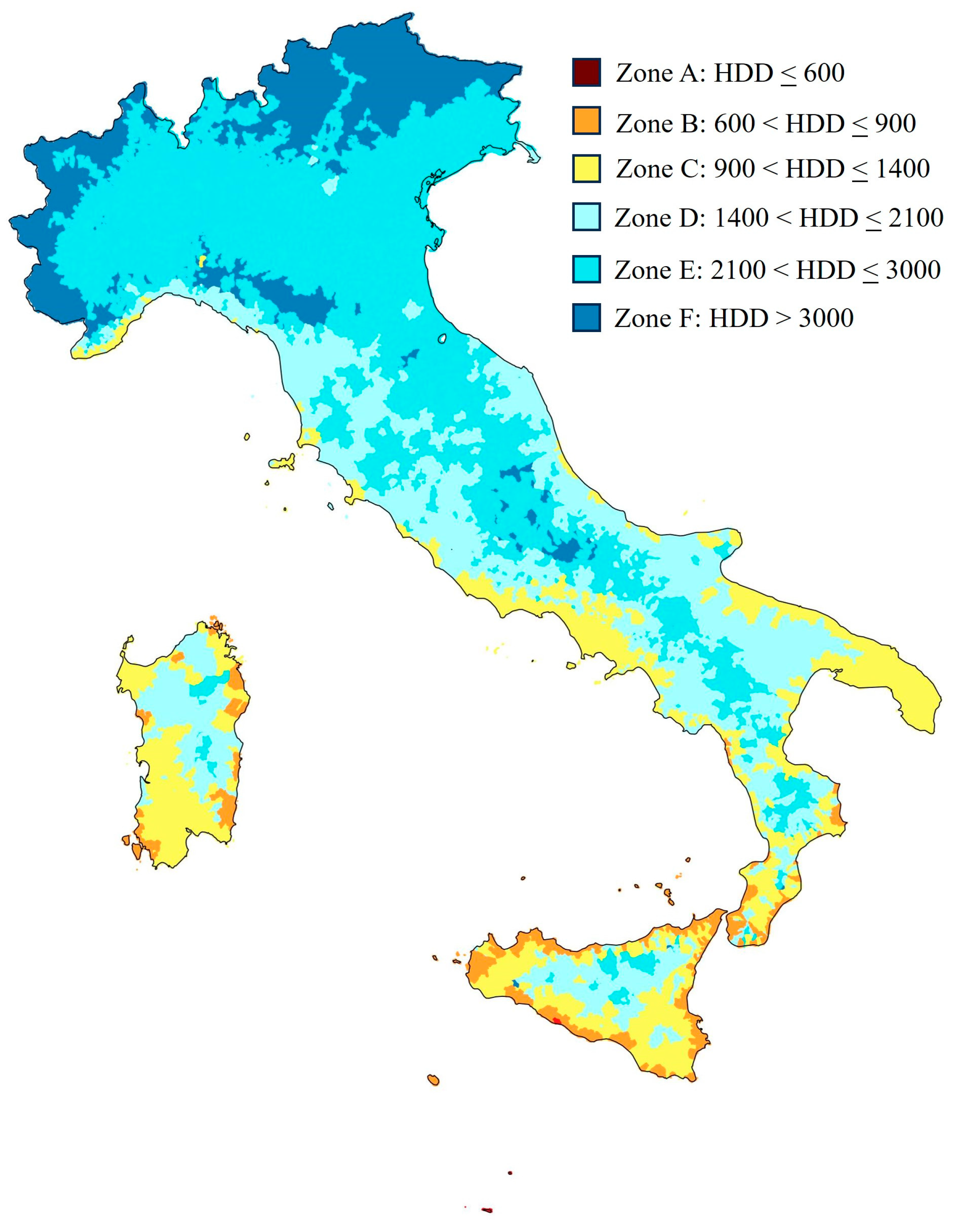
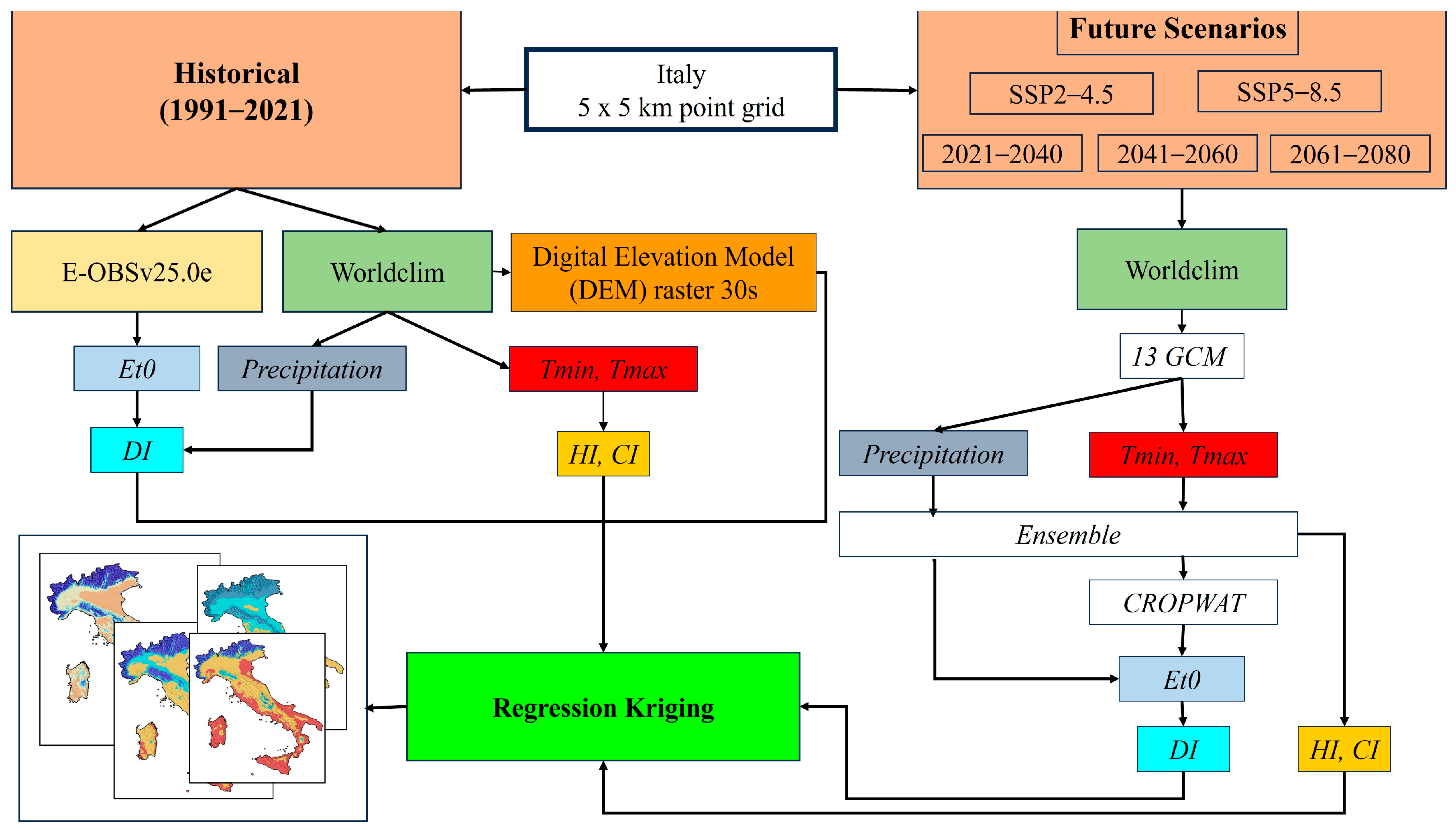
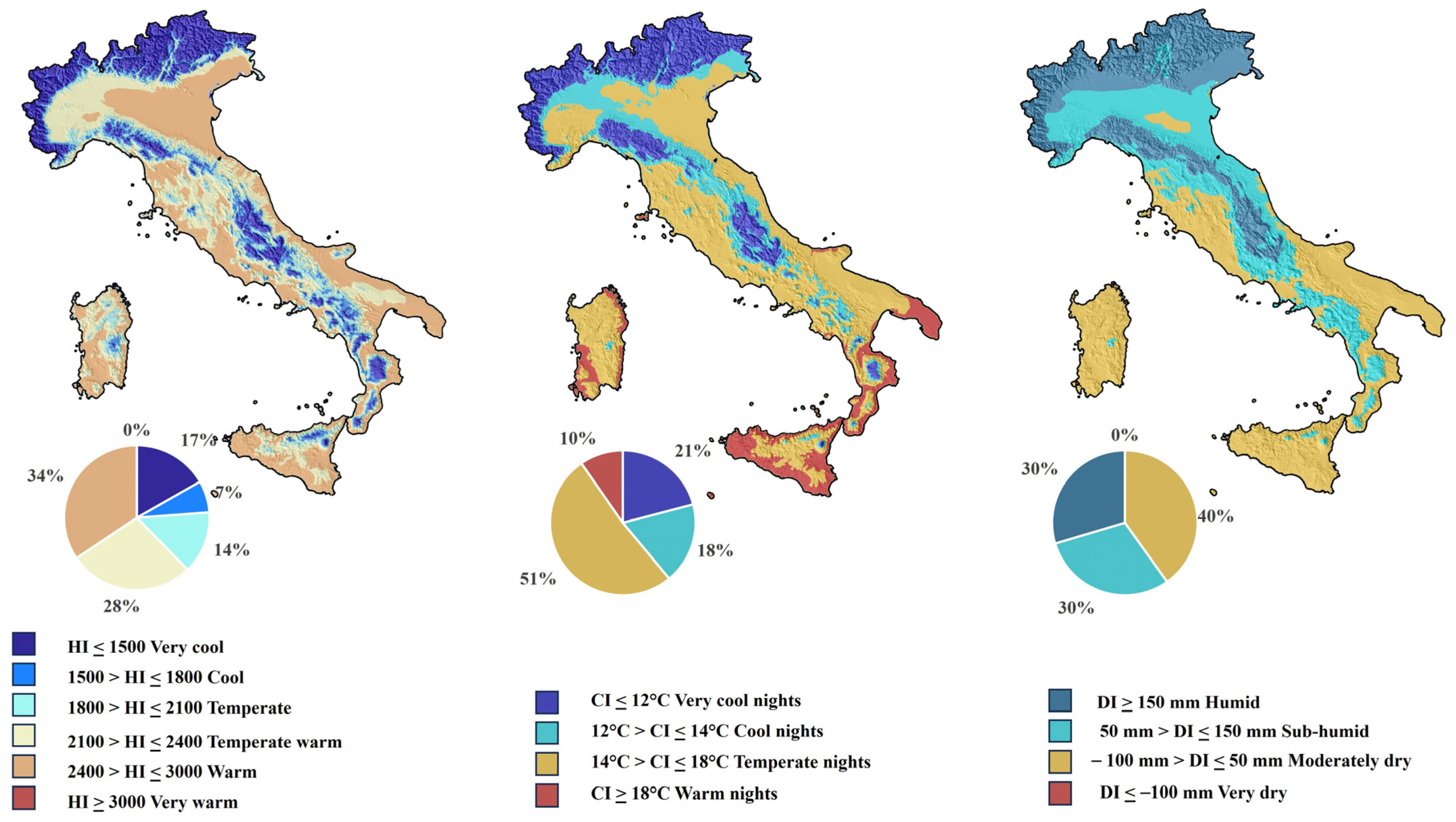
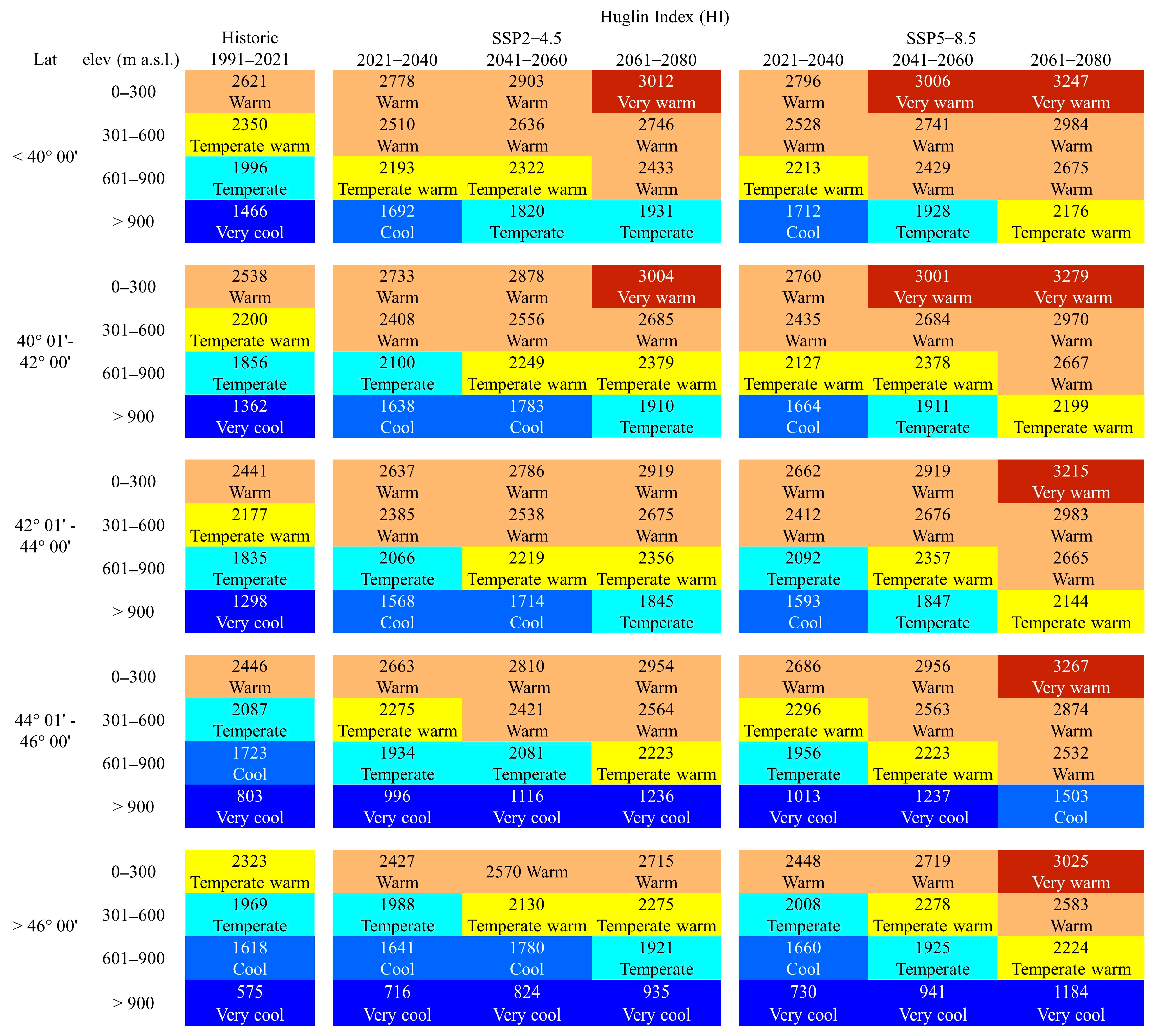

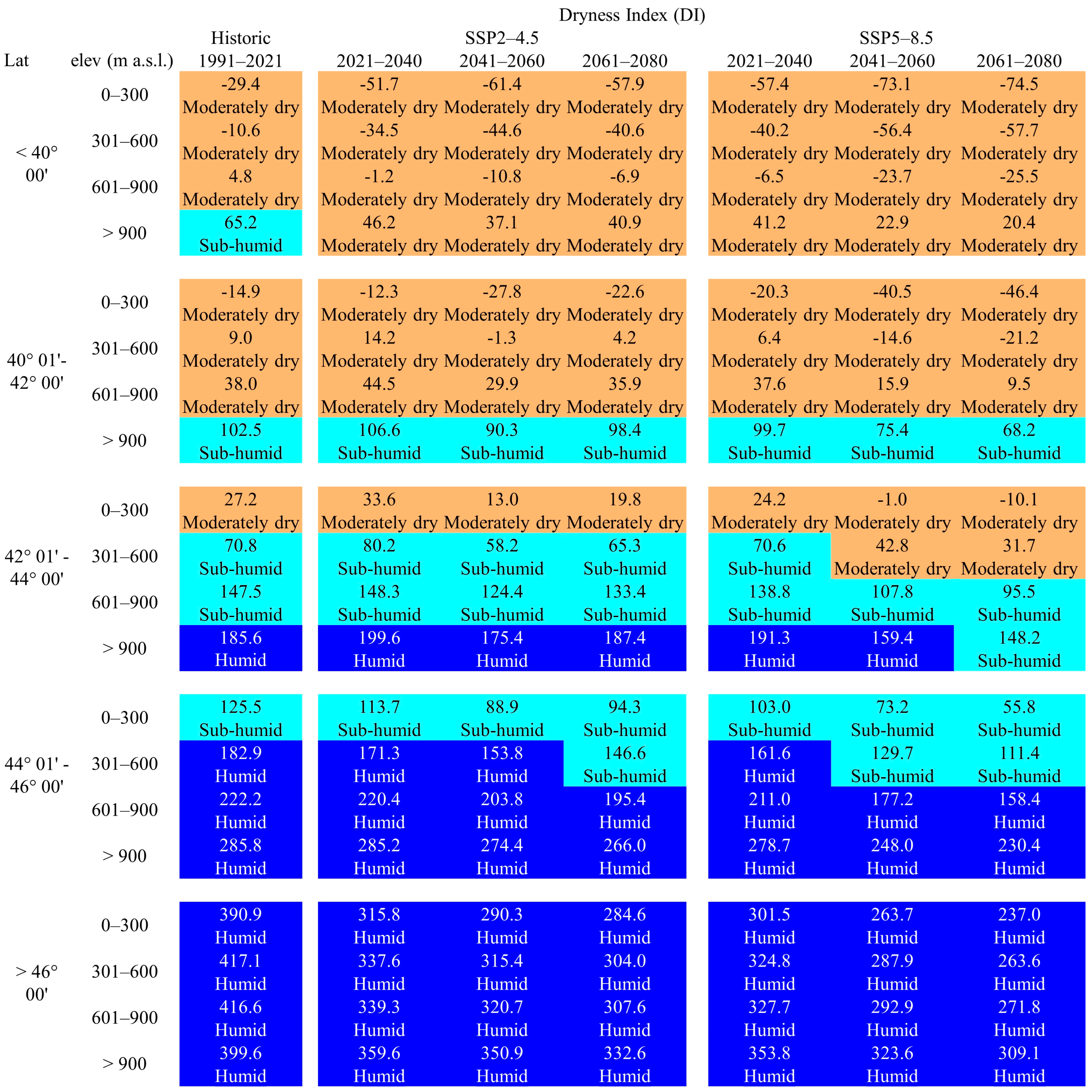

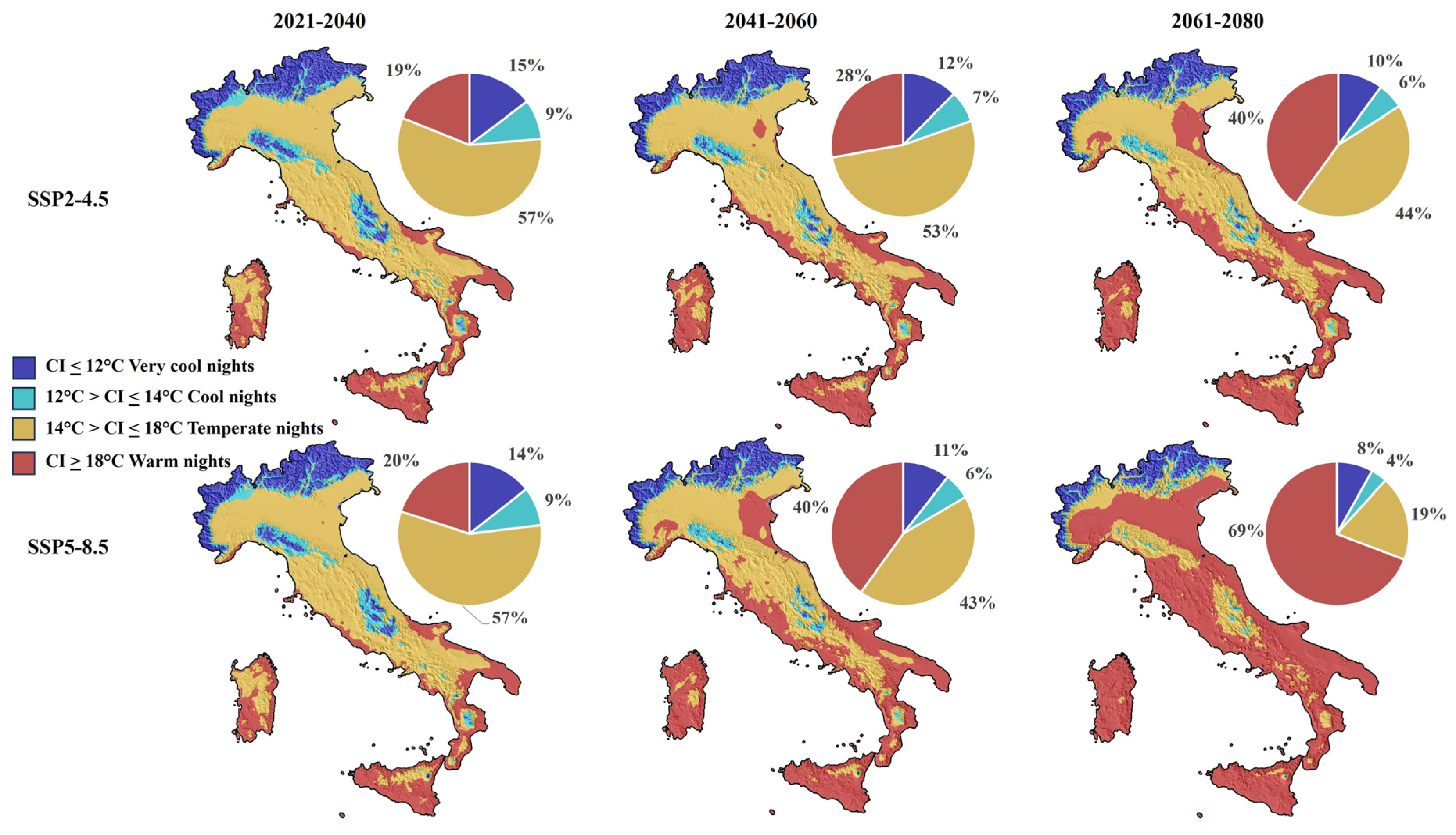
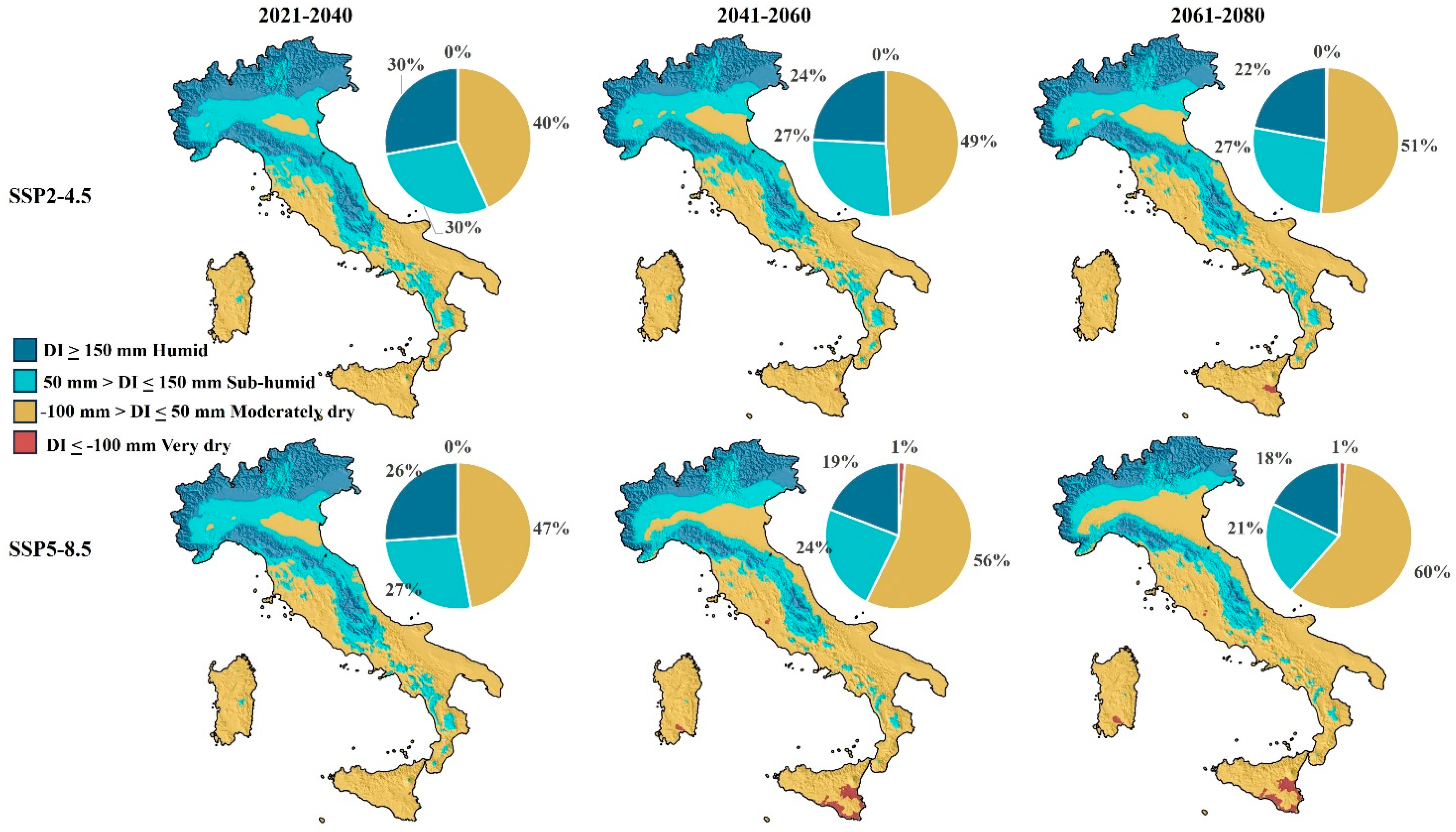
| Bioclimatic Index | Formula | Classes |
|---|---|---|
| Huglin index (HI) | Very cool < 1500 Cool = 1500–1800 Temperate = 1800–2100 Warm temperate = 2100–2400 Warm = 2400–3000 Very warm > 3000 | |
| d: adjustment for latitude/day length 1.05 for latitude above 46° 1.04 for latitude comprised between 44° and 46° 1.03 for latitude comprised between 42° and 44° 1.02 for latitude comprised between 40° and 42° 1.00 for latitude below 40° | ||
| Cool night index (CI) | CI = Tmin September | Very cool nights ≤ 12 °C Cool nights 12 °C–14 °C Temperate nights 14 °C–18 °C Warm nights > 18 °C |
| Dryness index (DI) | DI = Wo + P − Tv − Es | Very dry < −100 mm Moderately dry −100 mm–50 mm Sub-humid 50 mm–150 mm Humid > 150 mm |
| Wo: soil water reserve at the end of the growing season (mm) P: Precipitation (mm) Tv: ETPk potential grapevine evapotranspiration (mm) | ||
| where: | ||
| ETP potential evapotranspiration (mm) k coefficient of radiation absorption by vineyard (in the Northern Hemisphere: 0.1 for April, 0.3 for May, 0.5 from June to September) Es: ETP/N(1 − k) JPm | ||
| where: | ||
| N: number of days in the month JPm: monthly precipitations in mm/5 (number of days of effective evaporation from the soil per month) |
| Lat | Elevation (m a.s.l.) | % Area | HI | CI | DI | |||
|---|---|---|---|---|---|---|---|---|
| ZMK | β | ZMK | β | ZMK | β | |||
| <40°00′ | 0–300 | 49.8% | 3.03 ** | 7.43 | 3.43 *** | 0.05 | −3.40 *** | −1.51 |
| 301–600 | 26.7% | 3.03 ** | 7.28 | 3.64 *** | 0.05 | −2.72 ** | −1.44 | |
| 601–900 | 13.6% | 3.13 ** | 7.39 | 3.86 *** | 0.05 | −3.13 ** | −1.62 | |
| >900 | 9.9% | 3.03 ** | 6.86 | 3.71 *** | 0.06 | −2.18 * | −1.72 | |
| 40°01′–42°00′ | 0–300 | 49.7% | 3.50 *** | 8.31 | 2.89 ** | 0.06 | −2.45 * | −1.88 |
| 301–600 | 27.1% | 3.43 *** | 8.22 | 2.79 ** | 0.06 | −2.14 * | −1.81 | |
| 601–900 | 14.9% | 3.40 *** | 7.78 | 2.65 ** | 0.06 | −2.01 * | −1.67 | |
| >900 | 8.3% | 3.20 *** | 6.71 | 2.52 * | 0.05 | −1.97 * | −2.33 | |
| 42°01′–44°00′ | 0–300 | 46.7% | 3.84 *** | 9.29 | 2.07 * | 0.05 | −2.62 ** | −2.81 |
| 301–600 | 29.4% | 3.81 *** | 9.37 | 2.12 * | 0.05 | −2.31 * | −3.16 | |
| 601–900 | 12.8% | 3.67 *** | 8.92 | 2.12 * | 0.05 | −2.41 * | −3.23 | |
| >900 | 11.1% | 3.40 *** | 7.46 | 2.14 * | 0.05 | −2.24 * | −3.39 | |
| 44°01′–46°00′ | 0–300 | 54.6% | 3.50 *** | 8.53 | 1.63 n.s. | 0.04 | −2.52 * | −2.56 |
| 301–600 | 15.4% | 3.84 *** | 9.07 | 1.73 n.s. | 0.05 | −3.16 ** | −4.38 | |
| 601–900 | 9.3% | 3.81 *** | 8.75 | 1.87 n.s. | 0.05 | −2.89 ** | −3.88 | |
| >900 | 20.7% | 3.03 ** | 5.64 | 1.70 n.s. | 0.05 | −2.11 * | −2.98 | |
| >46°00′ | 0–300 | 5.5% | 2.82 ** | 8.73 | 1.12 n.s. | 0.04 | 0.54 n.s. | 1.31 |
| 301–600 | 6.8% | 3.09 ** | 9.16 | 1.31 n.s. | 0.03 | 0.17 n.s. | 0.35 | |
| 601–900 | 9.2% | 3.13 ** | 8.72 | 1.17 n.s. | 0.03 | 0.20 n.s. | 0.36 | |
| >900 | 78.5% | 2.79 ** | 5.16 | 1.29 n.s. | 0.03 | 0.27 n.s. | 0.32 | |
Disclaimer/Publisher’s Note: The statements, opinions and data contained in all publications are solely those of the individual author(s) and contributor(s) and not of MDPI and/or the editor(s). MDPI and/or the editor(s) disclaim responsibility for any injury to people or property resulting from any ideas, methods, instructions or products referred to in the content. |
© 2024 by the authors. Licensee MDPI, Basel, Switzerland. This article is an open access article distributed under the terms and conditions of the Creative Commons Attribution (CC BY) license (https://creativecommons.org/licenses/by/4.0/).
Share and Cite
Alba, V.; Russi, A.; Caputo, A.R.; Gentilesco, G. Climate Change and Viticulture in Italy: Historical Trends and Future Scenarios. Atmosphere 2024, 15, 885. https://doi.org/10.3390/atmos15080885
Alba V, Russi A, Caputo AR, Gentilesco G. Climate Change and Viticulture in Italy: Historical Trends and Future Scenarios. Atmosphere. 2024; 15(8):885. https://doi.org/10.3390/atmos15080885
Chicago/Turabian StyleAlba, Vittorio, Alessandra Russi, Angelo Raffaele Caputo, and Giovanni Gentilesco. 2024. "Climate Change and Viticulture in Italy: Historical Trends and Future Scenarios" Atmosphere 15, no. 8: 885. https://doi.org/10.3390/atmos15080885





